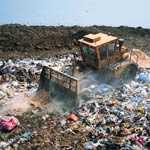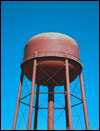NOTICE: This web page has been archived for historical purposes. Its content is no longer maintained, so information may be out of date and links may not work properly. For current Healthy Water features, please see the Newsroom, Features, & Observances page.
Ground Water Awareness Week March 10-16, 2013
 Much of the water we use comes from the ground. Learn more about ground water, the threats to its safety and how to protect your own ground water sources during Ground Water Awareness Week.
Much of the water we use comes from the ground. Learn more about ground water, the threats to its safety and how to protect your own ground water sources during Ground Water Awareness Week.
 Clean water is one of the world's most precious resources. People use water every day for a variety of reasons, such as drinking, bathing, recreation, agriculture, cooling, and industry. Although water plays an essential role in every person's life, many individuals are not aware that much of their water comes from the ground.
Clean water is one of the world's most precious resources. People use water every day for a variety of reasons, such as drinking, bathing, recreation, agriculture, cooling, and industry. Although water plays an essential role in every person's life, many individuals are not aware that much of their water comes from the ground.
National Ground Water Awareness Week, an annual observance sponsored by the National Ground Water Association (NGWA), is March 10-16, 2013. The purpose of this observance is to stress how important ground water is to the health of all people and the environment 1.
Ground Water Contamination
 Ground water is water that is located below the surface of the earth in spaces between rock and soil. Ground water supplies water to wells and springs and is a substantial source of water used in the United States. Thirty percent of all available freshwater comes from ground water 2, which supplies a significant amount of water to community water systems and private wells 3.
Ground water is water that is located below the surface of the earth in spaces between rock and soil. Ground water supplies water to wells and springs and is a substantial source of water used in the United States. Thirty percent of all available freshwater comes from ground water 2, which supplies a significant amount of water to community water systems and private wells 3.
Protecting ground water sources from contamination is an important priority for countries throughout the world, including the United States. Most of the time, ground water sources in the United States are safe to use and not a cause for worry. However, ground water sources can become contaminated with bacteria, viruses, parasites, and chemicals that can lead to sickness and disease.
Ground water contaminants sometimes occur naturally in the environment (for example, arsenic and radon), but are more often the result of human activities. These activities include incorrect use of fertilizers and pesticides; poorly sited, constructed or maintained septic systems; improper disposal or storage of wastes; and chemical spills at industrial sites 4,5. From 1971 to 2006, 54% of reported drinking water outbreaks were due to the use of untreated ground water (31%) or ground water treatment deficiencies (23%). The most common pathogens identified in ground water outbreaks during this period included Shigella spp., hepatitis A virus, norovirus, Giardia intestinalis, Campylobacter spp, and Salmonella spp 6.
 The presence of pathogens and chemicals in our drinking water can lead to health problems, including gastrointestinal illness, reproductive problems, and neurological disorders 7. Infants, young children, pregnant women, the elderly, and people whose immune systems are compromised because of AIDS, chemotherapy, or transplant medications may be especially susceptible to illness from certain contaminants. Concerns for ground water contaminants have led the U.S. Environmental Protection Agency (EPA) and individual states to develop new regulations to protect ground water in public water systems (the Ground Water Rule).
The presence of pathogens and chemicals in our drinking water can lead to health problems, including gastrointestinal illness, reproductive problems, and neurological disorders 7. Infants, young children, pregnant women, the elderly, and people whose immune systems are compromised because of AIDS, chemotherapy, or transplant medications may be especially susceptible to illness from certain contaminants. Concerns for ground water contaminants have led the U.S. Environmental Protection Agency (EPA) and individual states to develop new regulations to protect ground water in public water systems (the Ground Water Rule).
Is your household in either of these categories?
Are you among the almost 90 million Americans who get their tap water from a community water system that uses ground water?
 Seventy-seven percent of community water systems in the United States use ground water as their primary source, supplying drinking water to 30% of community water system users, or almost 90 million Americans 8. The U.S. Environmental Protection Agency (EPA) sets maximum concentration levels for many water pollutants and regulates drinking water quality in public water systems, including community water systems. You can find out more about your local drinking water quality and possible contaminants by viewing your consumer confidence report (CCR), which every utility company is required to provide to its customers.
Seventy-seven percent of community water systems in the United States use ground water as their primary source, supplying drinking water to 30% of community water system users, or almost 90 million Americans 8. The U.S. Environmental Protection Agency (EPA) sets maximum concentration levels for many water pollutants and regulates drinking water quality in public water systems, including community water systems. You can find out more about your local drinking water quality and possible contaminants by viewing your consumer confidence report (CCR), which every utility company is required to provide to its customers.
- More information on EPA's National Primary Drinking Water Regulations [PDF - 924KB]
- More information on community water systems
Are you among the 15 million American households who have their own private wells?
 An estimated 15 million American households get their water from private ground water wells, which are not subject to EPA regulations 9. Private ground water wells can provide safe, clean water. However, well water may be or become contaminated, leading to illness. It is the responsibility of the well owner to maintain their well and have the water tested on the recommended annual basis in order to ensure their water is safe from harmful contaminants 10. State and local health departments have resources available to help homeowners protect groundwater.
An estimated 15 million American households get their water from private ground water wells, which are not subject to EPA regulations 9. Private ground water wells can provide safe, clean water. However, well water may be or become contaminated, leading to illness. It is the responsibility of the well owner to maintain their well and have the water tested on the recommended annual basis in order to ensure their water is safe from harmful contaminants 10. State and local health departments have resources available to help homeowners protect groundwater.
More Information
References:
- National Ground Water Association. National Ground Water Awareness Week: March 10-16, 2013.
- USGS. Earth's Water Distribution. Updated March 2013.
- U.S. Environmental Protection Agency. Public Drinking Water Systems: Facts and Figures. Updated April 2012.
- U.S. Environmental Protection Agency. Drinking Water from Household Wells [PDF - 1.61MB]; 2002.
- Brunkard J, Ailes E, Roberts V, Hill V, Hilborn E, Craun G, Rajasingham A, Kahler A, Garrison L, Hicks L, Carpenter J, Wade T, Beach M, Yoder J. Surveillance for waterborne disease outbreaks associated with drinking water---United States, 2007--2008. MMWR Surveill Summ. 2011 Sep 23;60(12):38-68.
- Craun GF, Brunkard JM, Yoder JS, Roberts VA, Carpenter J, Wade T, Calderon RL, Roberts JM, Beach MJ, Roy SL, Causes of outbreaks associated with drinking water in the United States from 1971 to 2006. Clin Microbiol Rev 2010;23:507-28.
- U.S. Environmental Protection Agency. Drinking Water Contaminants: List of Contaminants and Their Maximum Contaminant Level (MCLs). Updated June 2012.
- U.S. Environmental Protection Agency. Fiscal Year 2010 Drinking Water and Ground Water Statistics [PDF - 115KB], Updated in 2012.
- US Census Bureau. Current Housing Reports, Series H150/09, American Housing Survey for the United States: 2009 [PDF - 2.56MB], U.S. Government Printing Office, Washington, DC: 20401. Printed in 2011 .
- U.S. Environmental Protection Agency. Private Drinking Water Wells: What You Can Do. Updated March 2012.
CDC works 24/7 saving lives and protecting people from health threats to have a more secure nation. A US federal agency, CDC helps make the healthy choice the easy choice by putting science and prevention into action. CDC works to help people live longer, healthier and more productive lives.
Get email updates
To receive email updates about this page, enter your email address:
Contact Us:
- Centers for Disease Control and Prevention
1600 Clifton Rd
Atlanta, GA 30333 - 800-CDC-INFO
(800-232-4636)
TTY: (888) 232-6348 - Contact CDC–INFO
 ShareCompartir
ShareCompartir


